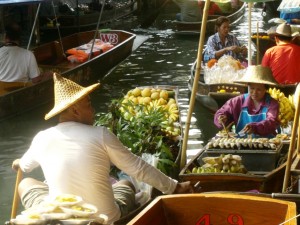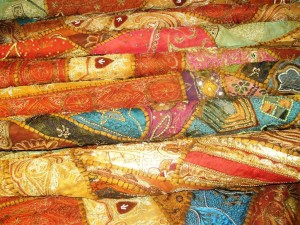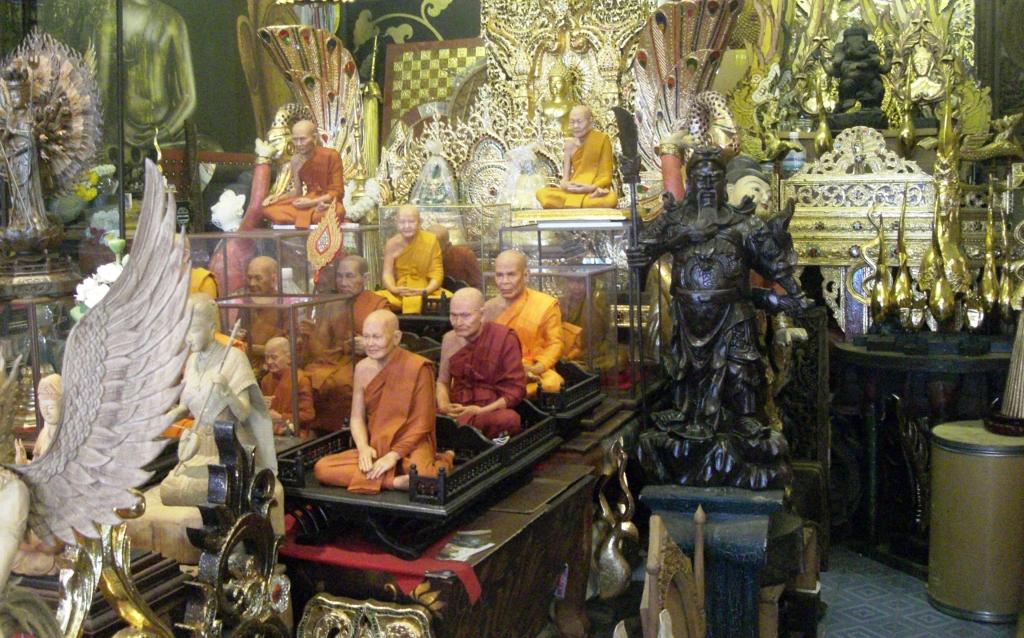I thought I could find my way by retracing my steps through the highlights: The silk fabric shop, the market stall with the thousand Buddha statues, the little booth with the mango wood carvings. But a hundred silk fabric shops later, a hundred stalls filled with Buddhas and wood carvings, I realize that I haven’t selected my landmarks well. I’m lost in the maze of Bangkok’s Chatuchak Weekend Market. Fortunately, I’m carrying a small map on which I’ve marked the entrance, where I’ll meet my companions after an hour or so. In the meantime, I have baht to burn.
Will I spend it on a fake Rolex? Silk pillow-covers? Jars of hot Thai chili peppers? If you can imagine it, it seems you can buy it here.
The Chatuchak Weekend Market is Thailand’s largest market, and with size comes variety: from street food to furniture, knick-knacks to clothing, jewelry to carvings to plastic kitchen supplies. It would take days to see all 10,000 official stalls (not to mention the thousands more operated by unlicensed vendors). Bustling but not aggressive, crowded but not claustrophobic, the Weekend Market draws tourists and locals alike, and provides an introduction to the many kinds of souvenirs available in Thailand.
Thailand’s Floating Markets

A few days later, I headed to the Damnoen Saduak, one of Thailand’s famed floating markets. Built along canals, the markets include fixed stalls on platforms, as well as boats: Vendors and buyers pull up alongside each other, exchanging fruits, spices, pots and pans, fabrics, and a hundred other products.
Damnoen Saduak is in Ratchaburi, about an hour away from Bangkok. Tours can be arranged from guide companies in Bangkok. They include a canal boat ride to the market, followed by free time to wander about.
While the flavor of the Damnoen Market is very local — most of what you’ll see is food and everyday goods — there are plenty of souvenirs on offer, too: I picked up some packets of dried spices, and a bamboo backscratcher (for about 60 U.S. cents). The earlier you can arrange to get there, the better the experience. Tour buses start arriving en masse at about 9 a.m. Photo buffs might want to to try to get there earlier in order to shoot pictures in the morning light without the crowds.
What to Buy in Thailand
The selection can be a bit overwhelming at first, but after diligently examining everything from religious statues to spices and sauces, here are my recommendations for some of the more unique, interesting, or just plain beautiful gifts I came across:

Fabric. Silk scarves are available everywhere, and make beautiful, inexpensive, and portable gifts. You’ll also find a wide selection of silk clothing, fabric purses, and ties. One of Bangkok’s popular tourist attractions is the Jim Thompson House, which commemorates the life of the well-known merchant who put Thai silk on the world’s maps. His house has been left as he lived in it. A museum shop at the entrance contains high-end silk designs; lower prices (and lower quality) can be found in the markets. (And if you don’t make it to the Jim Thompson House, there’s also a Jim Thompson shop at the airport.)
Hand-made Clothing. Why not go one step farther and have clothing made? Fabrics are everywhere waiting to be turned into dresses, shirts, and pants. Tourists in the know bring their favorite clothes from home: That pair of pants with the perfect fit that went out of style two years ago? The skirt you’ve almost worn out but can’t bear to part with? The favorite shirt you wish you’d had the foresight to buy in bulk quantities? You can have them reproduced by tailors in Bangkok.
Buddhas. Wood Buddhas, metal Buddhas, painted Buddhas, antiqued Budhhas, laughing Buddhas, meditating Buddhas, big and small Buddhas, and everything in between are available in shops and markets throughout Thailand.
Silver Jewelry. Chiang Mai, in northern Thailand, is known for its silver shops. Ornate plates and cups, some made on site, and carefully rendered jewelry in all price ranges are available.

Anything with an Elephant. Elephants are a symbol of Thailand. You can find them printed on fabric, carved into wood, crafted into jewelry, appliqued onto hand-bags, and in a hundred other guises. And here’s a twist on the idea: How about a painting made not of and elephant, but by one? At the Elephant Stay program in Ayutthaya, the UNESCO World Heritage Site of complex of ruined temples outside Bangkok, elephants are coached to “paint” pictures by their mahouts, and the results are surprising. They can be bought as souvenirs.
Spices and Sauces. Fresh spices can’t be imported, but dried and vacuum packed Thai spices can be brought through Customs. For a few dollars, packages are available that contain up to a dozen different typical Thai spices. Thai hot pepper sauces and sweet and sour dipping sauces are also a nice gift for a house-sitter or the neighbor who watches your cat. Check with an English-speaking guide so you know what you are buying!
Practicalities
Prices are low by western standards, but expect to pay real money for real quality. Bargaining is acceptable on the streets. Depending on the market and your skill, you may score a 20 – 50 percent reduction. In brick-and-mortar shops, a 10 percent “discount” might be offered, possibly more if you look both seriously interested and seriously reluctant to spend too much. This is a polite society where a smile is valued above all, so don’t let bargaining become tense and confrontational. The bad feelings are not worth the few cents you’ll save.
Note that a segment of the Thai tourist trade thrives on selling knockoffs of designer goods. Visitors headed to Europe should know that some European countries have strict laws about the importation of knockoffs that violate registered trademarks. Prominent signs at Suvarnabhumi Airport Bangkok warn travelers headed to Europe to be aware of their countries’ customs regulations before importing knockoffs of trademarked goods.




I love buying beautiful but cheap finds in Chatuchak Weekend Market in Bangkok. I got a couple of dried spices the last time I visited Thailand. I’m interested to buy some fabrics during my next Thai travel.:)
NOOOOOO!!!! The elephants are not “coached” to paint. Their mahouts use violence and force to control the movements of their trunks while they hold the paint brush. It’s really just another way that Thailand has exploited the already very endangered Asian elephant. Please do a little research before suggesting this to others!
I realize that happens. I realize it happens in Thailand. I was AT this particular place, which is a rescue place and a care facility. I watched how it was done. And I asked about it. I realize you are well intentioned, but the places I visited were NOT tourist-abuse places — They are staffed by volunteer animal nurses and veterinarians, and they do not do tourist rides and all that. The have volunteers come from all over the world to work there, caring for and rehabilitating elephants. The mahouts weren’t even necessarily touching the elephants while they were “painting” — they gently guided them, with their voices. Although I know and agree that there are plenty of horrible places that ARE as you describe. The ones that are not — that take in abused and injured animals and restore them to health — deserve support.